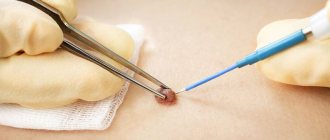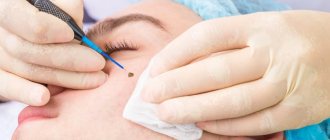A mole is a benign formation that appears on the body for various reasons. Usually nevi, as moles are also called, do not cause any inconvenience to people. But large tumors that rise above the skin can be accidentally injured by getting caught in clothing or some object. Many people do not know what to do if a mole is damaged and make standard mistakes, which sometimes lead to the development of melanoma.
A little about moles
In order to understand what will happen if you squeeze out a mole or have any other damaging effect on it, you need to understand what structures such as nevi are. In fact, moles are benign epidermal neoplasms that consist of cells containing an excess amount of the natural pigment melanin. The formation of such structures can be caused by various endogenous and external factors, ranging from hormonal imbalances to ultraviolet exposure.
Most often, nevi appear on the human body in childhood, but it is possible that they form in adulthood, which can be both a manifestation of a physiological norm and a signal of the development of a pathological process, including oncology. In general, moles of any location and visual characteristics are often associated with cancer processes, which, of course, has some basis. Dermatologists say that under the influence of certain accompanying factors, almost any mole can transform into melanoma - a dangerous oncological condition of the epidermal integument. One of these dangerous factors is the traumatic effect of the nevus on the body.
There are several types of nevi, each of which has an individual level of risk of injury:
- Flat moles. Visually, such pigmented structures do not protrude above the surface of the epidermal integument, which significantly reduces the likelihood of mechanical damage to this type of nevus.
- Convex moles. Protruding beyond the boundaries of the surface layer of the epidermis, convex formations are often subject to traumatic effects due to contact with tight clothing, shoes and accessories (jewelry, belts, etc.), as well as during the process of washing, combing or performing any physical work.
- Hanging moles. These neoplasms are more often subject to injury than others due to their morphological characteristics.
The last two groups of nevi require especially careful handling and constant monitoring. In addition, the risk group, whose representatives are more likely to experience damage to epidermal nevi, usually includes women and children. The former lead such statistics due to their adherence to tight, uncomfortable clothing and rough accessories that can injure the body of the mole, as well as due to the peculiarities of manicure. Children rip off or tear off moles most often unconsciously, during play.
Main causes of peeling
Itching, inflammation, and peeling of the surface of the nevus cannot be ignored. In some cases, they become the first symptoms of melanoma - a very dangerous disease with a high probability of death. Concomitant manifestations of the disease may include:
- rapid growth and deformation,
- fuzzy contours and asymmetry,
- color change - with malignancy, tissues may lighten or darken, inclusions of a different shade may appear in them,
- bleeding,
- appearance of cracks.
Peeling moles are also sometimes provoked by damage to the skin by clothing or accessories, and some dermatological diseases.
Injury to a mole: consequences
First of all, it should be noted that the development of melanoma is not always associated with damage to pigmented nevi and will not necessarily be a consequence of such a process. At the same time, doctors have proven that for moles that are initially classified as melanoma-hazardous, any trauma to their surface can lead to accelerated development of the cancer process. This is one of the main reasons why any nevi should be protected from aggressive damaging influences.
In addition to malignant transformation, we can identify several more unpleasant and dangerous consequences that a torn or torn off mole can entail:
- Heavy bleeding. The body of the nevus feeds many blood vessels and capillaries, which saturate the formation cells with oxygen and nutrients. Some moles, such as angiomas and hemangiomas, are composed entirely of a tangle of blood channels. It is in this regard that if a mole is damaged, severe bleeding can develop, which can most often be stopped only with the help of professional medical care. After visible healing, the mole often bleeds for a long time, which is a residual consequence of the injury.
- Attachment of infection. An open wound that forms at the site of a damaged nevus provides rapid access for infectious agents to the wound surface and, accordingly, to the entire patient’s body. As a result, not only a local infectious process can develop, but also a generalized pathological condition, accompanied by suppuration of the primary site of contamination.
- Inflammatory process. Often after mechanical trauma to a nevus, patients note swelling of the area around the mole and some hyperemia of the skin. This, together with pain when pressed, may indicate the development of inflammation. Such a reaction is sometimes accompanied by vasospasm, which is manifested by the appearance of a white spot around the torn mole. In the absence of professional medical care, such a process can also lead to suppuration of the wound.
- Formation of scars and scars. This aspect is especially concerning for the fair sex, because a situation where a woman scratches a mole on her face with a massive accessory or manicure is not uncommon. The consequence of such a careless attitude towards a nevus can be an undesirable aesthetic defect, which is formed against the background of excessive formation of connective tissue. In the future, such scars and scars can only be removed using hardware cosmetology techniques.
In order to avoid all these unpleasant phenomena, it is recommended to treat existing moles with care and attention and remove a defect located in an area of increased risk of injury in advance.
Why do nevi disappear?
The disappearance of a long-existing nevus may be a consequence of natural aging of the body, changes in melanin concentration due to dermatological diseases, exposure to ultraviolet radiation, or trauma. In most cases, such depigmentation is safe for humans, but still requires consultation with a specialist. In rare cases, fading of a pigment spot may indicate malignancy of its cells. Do not delay visiting your doctor if:
- the mole has peeled off and almost disappeared,
- its surface has lightened or darkened, become uneven in color,
- the skin around it is lightened, red, or inflamed.
Only an experienced dermatologist can determine the exact cause of such changes.
What to do if you have a problem like this
If the formation has disappeared, first aid should be provided. It consists of stopping bleeding and treating the wound with peroxide. Apply a sterile bandage or adhesive plaster to the wound. Then go to the hospital. If possible, place the fallen part in saline solution for examination. If a piece is lost, you can take the biomaterial from the wound.
During the diagnostic process, the malignant or benign nature of the formation is revealed. A dermatologist examines the formation through a dermatoscope, determines its origin, and prescribes treatment. After examination, the doctor prescribes a treatment method - surgery or laser therapy. You will need to consult an oncologist to determine the nature of the tumor. A plastic surgeon will remove traces of growth if the tumor is in a noticeable place.
At an appointment with an oncologist, tests are prescribed, the medical record is examined, the presence of complaints, and a hereditary tendency to oncology. Visual presence of symptoms – darkening, redness, peeling of the skin. A biopsy of the lesion is performed and a histological analysis of the biomaterial is performed to final confirm the diagnosis. To identify metastases affecting lymphatic vessels and distant organs, X-rays, MRI and CT are prescribed.
Timely detection and treatment of cancer in the initial stages will lead to success. The operation is performed under local anesthesia and is irradiated with high-frequency X-ray radiation. The therapy makes it possible to stop the atypical division of degenerated cells and to carry out a successful intervention to remove the cancerous tumor and the adjacent healthy epidermis.
The tumor is eliminated using a laser or liquid nitrogen. The procedures are painless, leaving a slight scar after burning or freezing. If metastases spread, chemotherapy is prescribed.
How to reduce the risk of nevus cell degeneration?
Even if an asymmetrical or flaky mole turns out to be benign, a dermatologist may recommend its removal. A correctly performed procedure will reduce the risk of cell malignancy and the development of melanoma. Only a doctor can choose the appropriate method for removing the tumor. You should not trust the procedure to specialists from beauty salons.
Are you looking for where to undergo safe mole removal in Maryino? Make an appointment with a dermatologist at our clinic. He will examine suspicious nevi and tell you whether they need to be removed.
All articles
5% discount Print coupon from our website
Ask your question on the website Get professional advice!
Can it fall off on its own?
Nevi under the influence of external and internal factors can fall off on their own. There are many invisible moles on the human body, face, and mucous membranes. They darken and change in size throughout life. Sometimes birthmarks cause inconvenience and are located in areas of high friction. Growths on the neck cling to jewelry, on the back to clothing, during bathing they are rubbed with a washcloth, on the face they interfere with shaving, on the head they interfere with combing.
Cells with a large amount of pigment, under the influence of external and internal factors, die and flake off. The processes take place in the summer. After tanning in the sun or treatments in a solarium, during puberty, menopause, pregnancy.
Constant mechanical impacts on the formation damage its integrity. Often such growths get rid of. Sometimes they dry out and fall off on their own. A good reason to see a dermatologist. There is a possibility of conversion to melanoma. If the process is started, malignant cells grow, moving through the lymphatic and circulatory system. Without diagnosis and lack of proper treatment, death is possible.
Dangerous accompanying symptoms
Oncologists and dermatologists determine the malignancy of the growth by symptoms:
- the size and shape of the birthmark changes;
- darkening, increase in pigmented tissue, appearance of a black dot in the center of the formation;
- peeling;
- severe itching of the growth and the skin around it;
- the appearance of erosion, bleeding ulcers;
- pain of increasing nature.
If any of the symptoms appear, contact the clinic immediately for help.
Possible complications and precautions
Moles vary in appearance and can transform into melanomas. After detachment, nothing bad will happen. To be sure of determining the malignancy of a tumor, you should consult your doctor. The main complication is the spread of a cancerous tumor, in advanced situations with a fatal outcome.
In some situations, the malignancy of a detached growth is determined by the following factors:
- by gender – women are less likely to experience degeneration of education;
- direction of nevus growth: hanging growths are often examined more closely.
To prevent the development of cancer, you should carefully monitor all formations: flat birthmarks or raised moles located throughout the body. If the formation begins to bleed or peel, you need to go to the clinic, do not wait until the problem goes away.
What should not be done if a mole is injured, torn off or cut off?
So, the injured mole needs help. Unfortunately, she doesn't always get it - some people follow the wrong advice from the Internet, while others make their own mistakes.
Here are three common mistakes:
1. Lack of wound care
Yes, sometimes carriers of damaged nevi simply hope that the tumor will heal on its own. There are not many of them. But there is a group of people who are accustomed to turning a blind eye to “light scratches.” Neglecting injuries can lead to blood poisoning. It is a rarity. But it happens.
2. Self-medication
This mistake usually does not lead to serious consequences. In most patients, moles heal safely and do not degenerate. But it also happens differently. Injured tumors rapidly mutate into insidious cancerous tumors that attack healthy tissue.
3. Removal of nevi before examination
Some people want to quickly get rid of bleeding, damaged moles. They are not interested in what caused the injury. Are these neoplasms dangerous or not? They run to the nearest beauty salon and demand that the nevi be urgently cut off or burned. Because of this, doctors do not detect skin cancer on time.
One more thing - do not take the word for everything that is written on the Internet on the problem that interests you. Even us.
Many continue to spread mythical information about the threat of traumatized tumors. It is also important to take into account differences between patients. In one person, the doctor will identify a precancerous tumor, while in another, all moles will turn out to be harmless. So your situation may be different from other people's examples. And radically.
If you have injured a mole to the point of bleeding, then first of all rely on the opinion of your doctor, and not on the advice of strangers who have not seen your nevi.
From the description of errors we return to wounded neoplasms. What problems do they cause?
How to properly monitor a mole after an injury?
Nothing complicated.
Just take a photo of the new growth every day.
Place a ruler next to it. This way you will know what to look for to estimate the size of the growth.
Constant observation is very useful if an injured mole does not heal for a long time.
It helps make a diagnosis. At your appointment, show the doctor how the tumor has changed and over how long.
How to photograph a nevus?
We recommend using a camera that will allow you to take high-quality photographs. Any changes are clearly visible on them. It's difficult to take photos like this with a phone camera.
We sorted out the observation.
What about the timing of treatment for damaged tumors?
Why does a mole fall off in pieces?
Sometimes large moles cause a lot of discomfort and interfere with normal life activities. In this case, they cling to clothing and are damaged during washing or rubbing against the surface of the washcloth. The nevus can fall off completely, but often only loses part of it.
A fallen piece is not a reason for panic or worry. To ensure that the mole is safe, it is submitted for histological analysis. During the study, the doctor will determine the structure of the tissues and the degree of danger of the tumor. Chipping of pieces of a mole also occurs for other reasons:
- ultraviolet irradiation;
- gradual drying and disintegration of the nevus;
- cancerous lesion.
There is no need to worry if the remaining mole does not itch, does not look inflamed, and there is no pain when pressed. Nutrients simply ceased to flow to it, and it is gradually destroyed.
What will happen next to the injured mole?
Any wound on a nevus or on regular skin will not disappear overnight. It will hurt a little and turn red, that is, inflamed. This cannot be avoided.
However, other unpleasant symptoms rarely appear.
Recommended actions:
- Disinfect the wound
- Stop the bleeding
- Wait for healing
The wound heals on average in two to three weeks.
What to do if an injured mole festers and hurts?
In this case, you may need the help of a doctor, because the appearance of pus from the wound may indicate complications.
Without them, the skin heals according to the standard scenario:
- In two days a protective crust grows
- Within two weeks the crust disappears
- In three weeks the wound disappears
It is very easy to recognize what an injured mole looks like. It is difficult to find a person who has never received scratches, bruises or other injuries in his life. They look the same on nevi. The protective crust on the new growths is clearly visible.
Although you can identify a wounded mole at home, to identify signs of degeneration you need the help of a doctor.
What to do if you have injured a mole?
So, damage could not be avoided. A bleeding wound appeared at the site of the tumor, which should not be left just like that.
What to do if a mole is cut or torn off?
Don't worry. It is easy to care for, and you will not need rare and expensive medications.
First you need to protect the wound from infection. Treat the neoplasm with an antiseptic. Chlorhexidine is best suited - it is a cheap remedy that is available in any pharmacy.
But we do not recommend smearing wounds with iodine. In this case, you will not be able to notice signs of possible inflammation.
Now about more severe cases.
What to do if you injured a mole until it bled?
Soak gauze or a piece of cotton wool in hydrogen peroxide and then apply it to the wound. This will stop the bleeding. Then you can fix the cotton wool with bandages or adhesive tape. This will prevent infection.
Other means will also help you.
How else can I treat an injured mole?
After disinfecting the wound, care must be taken to ensure that it heals properly. This will take more than one week. Usually the damage heals in about 20 days.
Which ointment is suitable for treating an injured mole?
To quickly restore the skin, use zinc ointment or calendula tincture, which disinfect, relieve inflammation and dry the wound.
Do you need a doctor's help?
You can easily heal a small wound on a nevus. First of all, it is important to prevent infection, and then the damage will heal without complications.
But then you can go to the doctor. Just in case.
It is not immediately clear in all cases why the tumor was injured - sometimes people only notice a bleeding wound. Then it’s worth taking a closer look at the damaged nevus.
Some injuries are caused only by strong friction or pressure, but others occur even with mild contact. This usually indicates the degeneration of a mole.
An examination will help to detect a cancer threat in time.
Not all your actions will be uniquely beneficial for the damaged tumors - some actions will only worsen the condition of the mole. Next we will present the Top 3 dangerous actions when nevi are injured.











